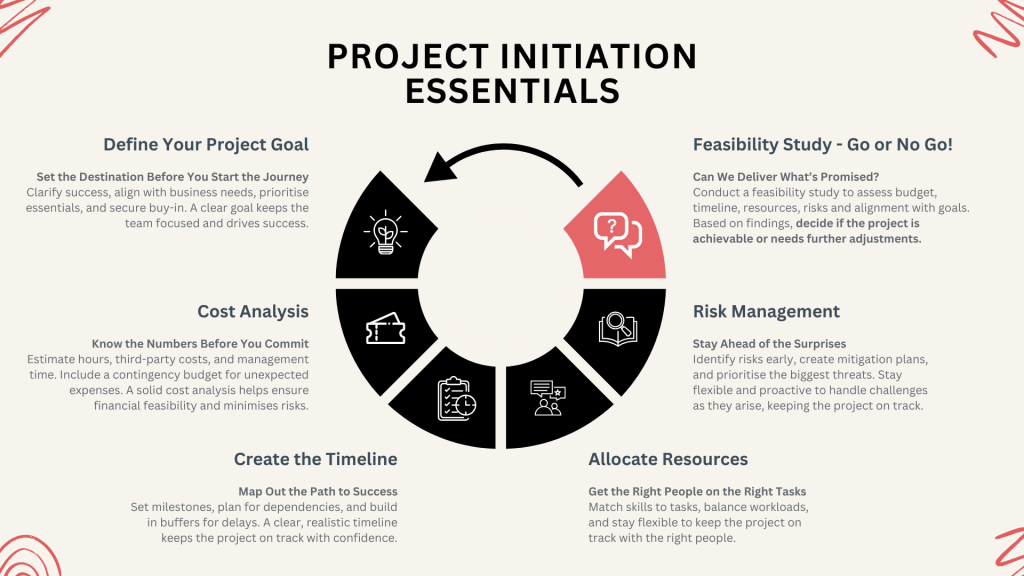Laying the Foundation for a Successful Project
Every successful project—whether big or small, follows a journey. Skipping steps or rushing ahead can lead to misalignment, missed deadlines, and unexpected challenges. But when you break it down into clear phases and focus on the right priorities at each stage, you create a roadmap for success, no matter which methodology you choose.
From setting clear project goals to defining scope and aligning stakeholders, the initiation phase lays the groundwork for success and defines if the project is feasible. This article walks you through the essentials of starting your project the right way, helping you avoid common pitfalls, keep everyone on the same page, and leading with confidence.
The Quick Guide
Before we get into the details, here’s a high-level look at the key stages in the initiation phase:

The Detailed Guide:
In this detailed guide, we’ll break down the key stages of the project initiation phase and focus on the importance of the feasibility study. Let’s dive into the details and make managing projects feel less overwhelming and more empowering!
1. Define the Project Goal: Set the Destination Before You Start the Journey
Every successful project starts with a clear destination. Without a well-defined goal, it’s like setting off on a road trip with no map—you might end up somewhere, but is it where you actually wanted to go? This stage is all about getting crystal clear on what success looks like so that every decision and action aligns with the end goal.
- Clarify Success: What does “done” look like? Define specific, measurable outcomes that indicate the project’s success.
- Align with Business Needs: Ensure the project goal directly supports wider business objectives, so it delivers real value.
- Set Priorities: Identify the must-haves versus the nice-to-haves to keep everyone focused on what truly matters.
- Gain Stakeholder Buy-in: Make sure key players agree on the goal from the outset to avoid conflicts and misalignment later.
- Make It Actionable: Frame the goal in a way that guides decisions and keeps the project moving in the right direction.
When you define your goal properly, you’re not just setting a target—you’re creating a shared vision that keeps your team motivated, your decisions strategic, and your project on track.
2. Cost Analysis: Know the Numbers Before You Commit
Before you can promise results, you need to be sure you can deliver them within budget. A detailed cost analysis helps you calculate all expenses involved in the project, ensuring it’s financially viable. This stage is about balancing ambition with realism, so you can confidently commit to timelines and deliverables without unexpected cost overruns.
- Estimate Team Hours: Break down each task and estimate the time required for design, development, testing, and deployment and project management.
- Account for Third-Party Costs: Include expenses for any external tools, software licenses, or subcontractors needed to complete the project.
- Factor in Management Time: There is bound to be reviews needed from the senior team, ensure you have including these times in your estimates.
- Include Contingency: If possible, allocate a contingency budget to cover unexpected costs or changes in scope.
- Communication Costs: Agree on clear channels, update frequencies, and decision-making processes to keep everyone informed and aligned. Once agreed, ensure all meetings and updates are factored into the overall budget.
A thorough cost analysis isn’t just about crunching numbers—it’s about setting realistic expectations and protecting profitability. By understanding the full financial picture upfront, you can negotiate confidently, minimise risks, and ensure the project is feasible.
3. Create the Timeline: Map Out the Path to Success
A great project isn’t just about what gets done—it’s about when it gets done. A realistic, well-structured timeline keeps everything moving smoothly, ensuring deadlines are met without last-minute chaos. This stage is all about balancing ambition with practicality, so your project stays on track without burning out your team.
- Set Key Milestones: Identify the major deliverables that mark progress.
- Factor in Dependencies: Map out what needs to happen first and what can run in parallel to avoid bottlenecks.
- Be Realistic About Deadlines: Give your team the time they actually need to deliver high-quality work.
- Plan for the Unexpected: Build in buffers to account for delays, annual leave, revisions, or unforeseen roadblocks.
- Keep It Visible: Make sure the whole team has access to the timeline so everyone knows what’s coming next.
A solid timeline isn’t just a schedule—it’s your project’s backbone. Get it right, and you’ll keep things moving forward with confidence, clarity, and minimal stress.
4. Allocate Resources: Get the Right People on the Right Tasks
Even the best project plan won’t succeed without the right people in place. Effective resource allocation ensures tasks are assigned to those with the right skills, availability, and capacity to deliver. This stage is all about setting your team up for success while avoiding burnout and bottlenecks.
- Match Skills to Tasks: Assign work based on expertise to ensure high-quality results, if people are learning that is fine, just allow for additional time.
- Balance Workload: Distribute tasks evenly to keep productivity high without overwhelming your team.
- Check Availability: Factor in holidays, other commitments, and competing priorities to avoid scheduling conflicts.
- Fill the Gaps: Identify any skill shortages early and bring in extra support or coordinate training if needed.
- Stay Flexible: Be ready to adjust assignments as the project evolves and new needs arise.
Smart resource allocation means your team can work efficiently and effectively—keeping your project on track without unnecessary stress or delays.
5. Risk Management: Stay Ahead of the Surprises
No project runs 100% smoothly—there are always challenges along the way. But the difference between a stressful scramble and a smooth recovery is preparation. Identifying risks early and having a plan in place means you can handle issues before they derail your project.
- Identify Risks: Review the entire project and pinpoint potential risks before getting started.
- Create Mitigation Plans: Develop strategies to prevent risks from escalating into issues.
- Prioritise the Biggest Threats: Focus on the risks that are likely to have the greatest impact.
- Plan for the Worst: Have contingency plans in place so you can react quickly if things go off track.
- Monitor Throughout: Review regularly as the project progresses and adjust plans as needed.
Proactive risk management isn’t about expecting the worst—it’s about being ready for anything. By staying ahead of potential challenges, your project stays in control, no matter what comes your way.
6. Feasibility Study: Can We Deliver What’s Promised?
Before starting any project, it’s essential to check if it’s truly achievable. A feasibility study helps you assess costs, timelines, and resource availability, setting clear expectations and avoiding surprises.
You’ve defined the scope, calculated costs, mapped out the timeline, checked resource availability, and identified risks. Now, it’s about deciding if this project is realistic.
- Is the budget feasible?
- Will the profit margins justify the effort?
- Can deadlines be met without overloading the team?
- Do you have the right people available?
- Does the project align with your company’s goals?
- Can you deliver high-quality results?
- Will this project strengthen your client relationship and reputation?
Go or No-Go Decision: Based on your findings, decide if the project is viable or if changes are needed. A solid feasibility study ensures you have the budget, resources, and timeline to deliver what’s promised, building trust with your client from the start.
That’s a wrap for part two! Remember, some tasks might take longer than others—and that’s completely fine. The key is to look at the project as a whole and assess its feasibility before diving in. Chances are, the first time you review everything, it won’t be a clear “yes.” The important part is going back and figuring out what can be adjusted to make it work and set it up for success. This phase often goes through several iterations before reaching a final “go” decision, so don’t lose heart if it’s not a yes right away. I’m here cheering you on every step of the way. You’ve got this!
Want more? Stick around!
Over the next few weeks, I’ll be diving deeper into each stage of the project journey, sharing practical tips to help you stay on track and deliver with confidence. Stay tuned!
